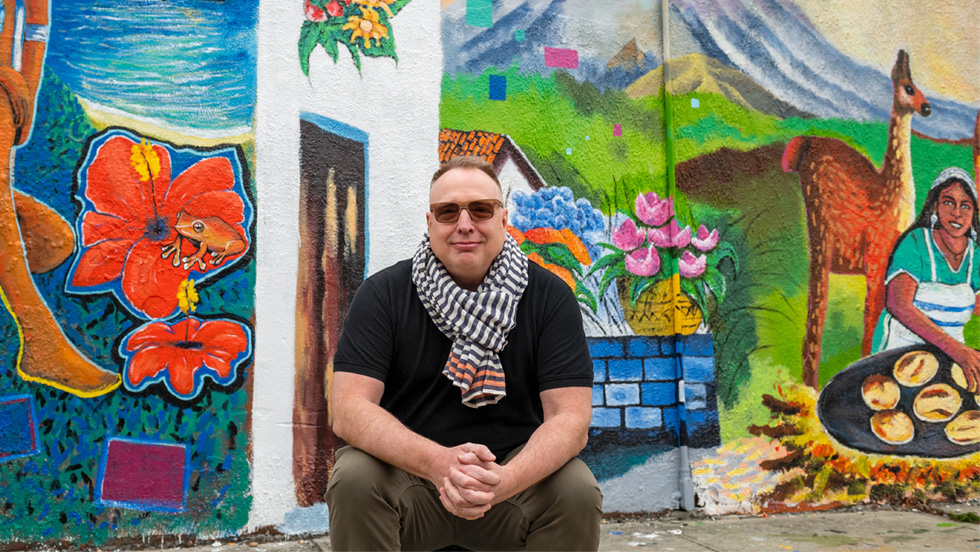
Latinx street art illuminates the immigrant experience and history of labor in Texas, countering societal erasures.
When Rob Linné, PhD, professor in the Ruth S. Ammon College of Education and Health Sciences, was 12, he spent a summer living in Guadalajara, Mexico, as part of a Boy Scout exchange. His host mother took him on a tour of the famous Orozco murals, a series of fiery political frescoes painted by left-wing artist José Clemente Orozco. “I felt I was walking through a spectacular, larger-than-life comic book,” he remembers. “The images were so powerful, and they told stirring stories of the people overcoming great oppression.” A decade later, just beginning his teaching career in Austin, Texas, at a predominantly Latinx school, Dr. Linné “had another epiphany sparked by murals.” The textbooks he was given for class did not reflect his students’ cultural heritage, so he turned to the murals adorning local neighborhood walls as inspiration. When asked to study these “texts,” he said, “students came to life, given the chance to talk seriously about these works in a way that validated their families, their life experiences and their histories.”
Now, Dr. Linné is revisiting the art form in a new article, “Latinx Murals of Texas: Memorials to Immigrant Experience, WorkingClass History, and Solidarity,” part of the edited collection Where Are the Workers? Labor’s Stories at Museums and Historic Sites (University of Illinois Press, 2022), which makes a strong argument for its transformative potential. 1 Murals, he asserts, can “give voice to the underserved and underrepresented while facilitating community pride and inspiring activism.”
In recent years, politics has infiltrated American educational institutions. News reports detail the banning of texts by states and school boards, the omission of historical topics from curricula and the censoring of educators. Relying on museums, memorials and other historical sites for insight into what Dr. Linné calls the “sharp edges of history” is not a safe bet, either. Although these sites do “play a vital role in educating the public and enlivening civic discourse,” he writes, they often don’t tell certain stories for fear of ruffling influential feathers.
The history of labor in Texas suffers from similar representative distortions, chief among them the fallacy that there is no history of labor. In fact, the only labor memorials in the state are roadside historical markers. “Progressive politics in the region has remained especially timid and apologetic in recent decades, in part because working-class people have been so successfully cut off from any history of resistance,” Dr. Linné notes in the article. Murals across Texas tell a different story, however.
Since the Mexican American muralism revival of the 1960s, Latinx street artists in big cities and small border towns alike have proclaimed their pride on the walls of grocery stores, community centers and schools. Their murals are a “creative bricolage” that mix imagery from ancient Mexican history with “slice-of-life images of farm life, soccer and home cooking,” effectively countering the “negative representations (or invisibility) offered up by mainstream media and educational institutions.” But these bold, colorful pieces do more than memorialize culture—they bring to life the hard-fought struggles of the Texas labor movement that have been erased from schools and museums. “By juxtaposing images of the barrio with great revolutionary heroes and labor leaders,” Dr. Linné writes, “the artists were encouraging the viewer to consider their material lives and pocketbook issues in the framework of a larger political past, present and future.”
If marginalized voices are destined to be excluded from today’s institutional memory, “we can go to the streets and the local community to make sure our students get a full education that isn’t so whitewashed,” Dr. Linné says. But in order to keep these alternative sites of history alive, he believes, we must actively engage with them. Even as new generations of artists continue to conjure their own histories on neighborhood walls, the public can honor Latinx working-class culture by seeking out street art to absorb its messaging. Through this collaborative process, he concludes, marginalized communities are able to “tell their own stories, memorialize working-class histories written out of the ‘great men’ texts, and build the solidarity needed to take on the continuing fights for social and economic justice.”
¹Linné, Robert. “Latinx Murals of Texas: Memorials to Immigrant Experience, Working-Class History, and Solidarity.” Where Are the Workers? Labor’s Stories at Museums and Historic Sites, edited by Robert Forrant and Mary Anne Trasciatti. University of Illinois Press, 2022.